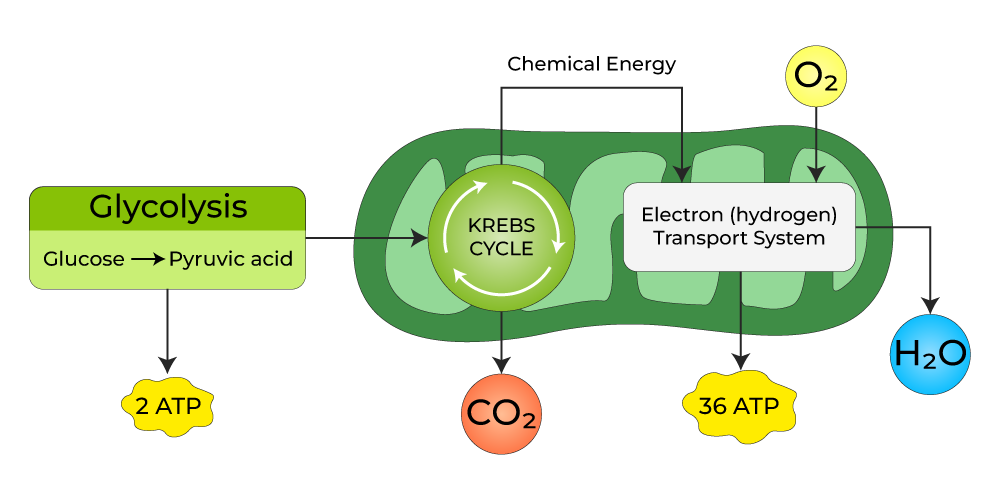Aerobic Respiration
Last Updated :
08 Sep, 2023
Aerobic respiration is a metabolic process of producing energy required by eukaryotic cells to carry out various cellular activities. It occurs in the presence of oxygen to carry out the oxidation of organic molecules, resulting in the production of ATP, carbon dioxide, and water. It begins with glycolysis in the cytoplasm, followed by the transition reaction and the Krebs cycle in the mitochondria, and ends with the electron transport chain and oxidative phosphorylation in the inner mitochondrial membrane.
Aerobic Respiration Definition
Aerobic respiration is cellular respiration that uses oxygen to convert food glucose and other organic molecules into energy, in the form of adenosine triphosphate (ATP).
What is Aerobic Respiration?
Aerobic Respiration can be defined as a set of metabolic reactions and processes that occurs in the cells of organisms to convert chemical energy from nutrients into ATP, and then release carbon dioxide, water and other waste products. It produces a large number of ATP compared to anaerobic respiration, making it the main energy-producing process in living organisms that utilize oxygen. It help in carrying out various cellular functions such as muscle contractions, cell division, and maintaining body temperature.
The overall chemical equation for aerobic respiration is:
C6H12O6 + 6O2 → 6CO2 + 6H2O + energy (ATP)
The above chemical reaction shows that the glucose is broken into the chemical energy in the presence of oxygen, which is used by the cell for various cell functions. The end products of the aerobic respiration equation are Carbon dioxide, Water, and ATP. Around 2900kJ of energy is released during aerobic respiration.
Also Read: Respiration
Aerobic Respiration Diagram
In aerobic respiration different metabolic processes are involved i.e glycolysis, TCA cycle, and Electron Transport Chain. Below is the diagrammatic representation of aerobic respiration, showing all the processes involved in it.

Steps of Aerobic Respiration
Aerobic Respiration is a multistep enzymatic process that is carried out in four stages:
- Glycolysis
- Pyruvate Decarboxylation (Transition Reaction)
- Krebs cycle
- Electron Transport Chain (ETC) and Oxidative Phosphorylation
Glycolysis
The name “glycolysis” originates from the Greek words “glycose,” which means “sugar,” and “lysis,” which means “dissolution.” The glycolysis process is the first phase in the aerobic respiration process that takes place in the cytosol. Glycolysis is the metabolic pathway that converts glucose into pyruvate and produces ATP and NADH. Both end products are further used in different aerobic respiration steps.
Pyruvate Decarboxylation (Transition Reaction)
It is the 2nd step of aerobic respiration. The pyruvate molecule formed in glycolysis is then transported into the mitochondria. In the mitochondrial matrix, pyruvate is converted into Acetyl-CoA through decarboxylation (removal of a carbon dioxide molecule). Two molecules of NADH are produced.
Krebs Cycle
Krebs cycle also known as the Citric Acid cycle or the Tricarboxylic Cycle (TCA). It is the third stage of aerobic respiration. Citric acid is produced when the oxaloacetate is combined with the acetyl co-enzyme-A. Further citric acid cycle undergoes a chain of reactions. The end products of the Citric Acid cycle are 2CO2 + 1ATP + NADH and FADH. The end products are further used in the last step of aerobic respiration.
Electron Transport Chain (ETC) and Oxidative Phosphorylation
The electron transport chain is the fourth and last step of aerobic respiration. Electrons carried by NADH and FADH2 from glycolysis, pyruvate decarboxylation, and the Krebs cycle are transported in the inner mitochondrial membrane. The synthesis of ATP from ADP and inorganic phosphate takes place through a process called oxidative phosphorylation. Oxygen act as the final electron acceptor in the ETC, and form water. This process generates a large amount of ATP (approximately 28-34 ATP molecules) for each molecule of glucose.
Importance of Aerobic Respiration
Importance of Aerobic respiration are as follows:
- Aerobic respiration is highly efficient process that produces a large amount of ATP, which is the energy currency of cells.
- It enables the complete oxidation of glucose and other organic molecules, minimizing waste products.
- Compared to anaerobic processes, aerobic respiration maximizes ATP production per glucose molecule.
- Aerobic respiration is important for multicellular organisms as they complete their high energy demands.
- It helps in the removal of carbon dioxide from the body.
- The heat generated during aerobic respiration contributes to maintaining body temperature in warm-blooded animals.
- Aerobic respiration provides oxygen for various metabolic processes, such as lipid metabolism and detoxification.
FAQs on Aerobic Respiration
1. What is aerobic respiration?
Answer:
Aerobic respiration is a biological process where cells use oxygen to convert glucose and other organic molecules into energy (ATP), carbon dioxide, and water.
2. What are the 4 stages of aerobic respiration?
Answer:
Aerobic Respiration is a multistep process that involves various enzymes. The process occur in four stages: Glycolysis, Pyruvate Decarboxylation (Transition Reaction), Krebs cycle, Electron Transport Chain (ETC) and Oxidative Phosphorylation.
3. Where does aerobic respiration take place in cells?
Answer:
Aerobic respiration occurs primarily in the mitochondria of eukaryotic cells, where various stages of the process unfold.
4. How is aerobic respiration different from anaerobic respiration?
Answer:
Aerobic respiration requires oxygen and is more efficient, producing a higher amount of ATP. Anaerobic respiration occurs without oxygen and generates less ATP but can be a temporary solution in oxygen-deficient conditions.
5. What is the role of oxygen in aerobic respiration?
Answer:
Oxygen serves as the final electron acceptor in the electron transport chain, allowing the process to continue and preventing the accumulation of toxic byproducts.
Share your thoughts in the comments
Please Login to comment...